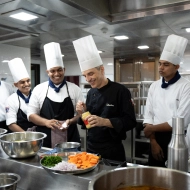
Fermented food is slowly capturing the industry’s attention mainly for its distinct flavor, an increased interest in Asian cuisine and its health benefits.
In food processing, fermentation is the anaerobic conversion of carbohydrates to alcohols, carbon dioxide or organic acids utilising yeasts, bacteria, or both. This process makes fermented food healthier and easy to digest while also giving it a distinct taste. Culinary institutes are making changes in the curriculum to ensure the use of fermented foods in cuisine.
But what’s the reason for the sudden popularity of fermented foods? One explanation is that yogurt, and by extension greek yogurt, has made a huge leap in the breakfast category. This has ushered in a slew of probiotic-rich foods, and consumers are now more eager to try kombucha tea or seed cheese as a result. Probiotics make the gut healthier and has made it a favourite with young health enthusiasts.
The microorganisms that naturally arise during the fermentation process are a major benefit of fermented foods. Probiotics can help with weight loss, healthier skin, improves immunity, in addition to maintaining a healthy gut. The body can absorb more nutrients from meals since the digestive system has the right combination of bacteria and enzymes.
A wide range of vegetables, teas, and yogurts, in addition to pickles and beer, are included in fermented foods. Over the last four years, menu penetration for greek yogurt and pickled vegetables has grown by triple digits, with the fine dining sector seeing the most rise.
The following are the most popular fermented dishes making waves in the local food and beverage scene:
1. Yoghurt is the most commonly seen fermented food in the world. Live bacteria, such as Lactobacillus and Bifidobacterium species, are added to milk to preserve it.
2. Kefir is another fermented milk beverage created by combining milk with kefir grains.
3. Sourdough is a popular bread in specialty cafés. It’s a type of bread created from a mixture of flour and water that has been fermented by yeasts and bacteria.
4. Kombucha – a sweetened black or green tea drink fermented by a bacteria called “SCOBY” (Symbiotic Colony of Bacteria and Yeast) is now a rage in cafes.
Fermented foods have always formed a big feature of Japanese and Korean cuisine. Expect to see fermented condiments, side dishes, and cocktails at the hippest restaurants now and in the future to bring astonishingly nuanced flavours to your table.









